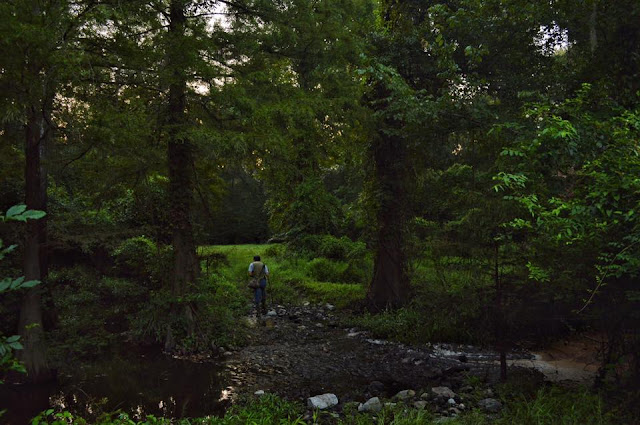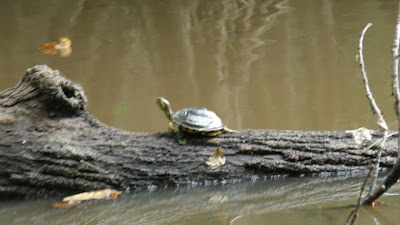My brother Brian Carlisle and I returned to the Stronghold on August 19, after many months' absence. Our goal was a quick survey of our old haunts, to get a feel for the area after our unusually wet summer, and to reconnect with what for us has become a deeply spiritual place.
A fast-retreating quarter moon before a hazy dawn found us far along the old trail I call Hollow Man Road, which cuts north-south through the Hutson Lake sector in the north-central Pascagoula Wildlife Management Area (WMA). Little if any wind moved for the duration of our hike, and the humid air warmed quickly. The denizens of the Swamp kept mostly silent and largely to themselves, though we encountered numerous golden silk orb weaver spiders, almost comically fearful of us despite their menacing appearance. It was a quick trip down to the relict baldcypress Hollow Man, where we set up a brief Watch in the deep woods along his small lake. A pair of Pileated Woodpeckers livened things up for a few minutes, and I spotted a lone Yellow-crowned Night Heron wrangling something reddish out of the muck on the shore opposite. Some distant, heavy tapping, likely Pileateds at work, gave us pause; and the drumming of red-headed woodpeckers at times rang out over the still bottomland to the north and east of our position. After an hour or so we decided to seek the air conditioning of Brian's truck. On the way, we spotted at least two juvenile Little Blue Herons and a white ibis haunting still waters among the trees, but few other feathered things aside from the usual crows and cardinals, and no mammals at all. It truly is the Spiders' time, and they are welcome to it. It is short enough.
From Hutson Lake we drove north, crossing Mississippi Highway 26 to another section of the WMA. We put our kayaks in at Dace Lake (or Dacy Lake, depending on the map), a small oxbow we have hiked near and visited a number of times, but never kayaked. It was around ten in the morning, and nothing was moving around the lake, save a small family of white ibis and a few turtles. Repairs I made over the summer to my boat, the Kuhn, seemed to have been successful, confirming the craft will be able to bear me again beyond terra firma, as needed. As usual, I have some ideas where I would like to explore in the months ahead.
A fast-retreating quarter moon before a hazy dawn found us far along the old trail I call Hollow Man Road, which cuts north-south through the Hutson Lake sector in the north-central Pascagoula Wildlife Management Area (WMA). Little if any wind moved for the duration of our hike, and the humid air warmed quickly. The denizens of the Swamp kept mostly silent and largely to themselves, though we encountered numerous golden silk orb weaver spiders, almost comically fearful of us despite their menacing appearance. It was a quick trip down to the relict baldcypress Hollow Man, where we set up a brief Watch in the deep woods along his small lake. A pair of Pileated Woodpeckers livened things up for a few minutes, and I spotted a lone Yellow-crowned Night Heron wrangling something reddish out of the muck on the shore opposite. Some distant, heavy tapping, likely Pileateds at work, gave us pause; and the drumming of red-headed woodpeckers at times rang out over the still bottomland to the north and east of our position. After an hour or so we decided to seek the air conditioning of Brian's truck. On the way, we spotted at least two juvenile Little Blue Herons and a white ibis haunting still waters among the trees, but few other feathered things aside from the usual crows and cardinals, and no mammals at all. It truly is the Spiders' time, and they are welcome to it. It is short enough.
From Hutson Lake we drove north, crossing Mississippi Highway 26 to another section of the WMA. We put our kayaks in at Dace Lake (or Dacy Lake, depending on the map), a small oxbow we have hiked near and visited a number of times, but never kayaked. It was around ten in the morning, and nothing was moving around the lake, save a small family of white ibis and a few turtles. Repairs I made over the summer to my boat, the Kuhn, seemed to have been successful, confirming the craft will be able to bear me again beyond terra firma, as needed. As usual, I have some ideas where I would like to explore in the months ahead.
The old field between Hutson Lake and a network of sloughs that stretches south to the Lord God Tree, Elephant Man Swamp, emptying into the Pascagoula between Pierce Lake and Hollow Man Lake. Photo: Brian Carlisle.
Photo: Brian Carlisle.
Photo: Brian Carlisle.
Photo: Brian Carlisle.
Near this year's new beaver dam. Photo: Brian Carlisle.
The dam has been broken, and is possibly now abandoned. Photo: Brian Carlisle.
Photo: Brian Carlisle.
Photo: Brian Carlisle.
From our vantage point by Hollow Man Lake. Photo: Brian Carlisle.
Photo: Brian Carlisle.
Dace Lake launch. Photo: Brian Carlisle.
The lake lay still and silent. Photo: Brian Carlisle.
I seldom manage to get this far ahead of my brother. Photo: Brian Carlisle.
Photo: Brian Carlisle.
Photo: Brian Carlisle.
Photo: Brian Carlisle.
I had to move fast to snap this photo. As I've noted before, it is difficult for me to manage to photograph wildlife from the kayak, which seems to have a mind of its own at such moments.
The bottomland lies still and dreaming while August simmers, but change is afoot. The days are already cooling here, enough to take the edge off a hot day hike in the Swamp. After this rainy summer, I wonder what challenges we will face come fall and winter -- paths newly revealed, others now hidden, all at the whim of the River.
I am studying my maps.






















And after reading this, it's making me wonder what format an intelligent search might have, in these cooler coming months, before the IBWOs become mating-active.
ReplyDelete